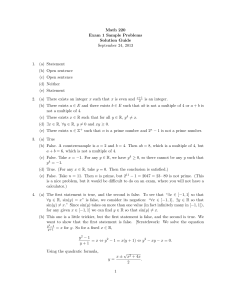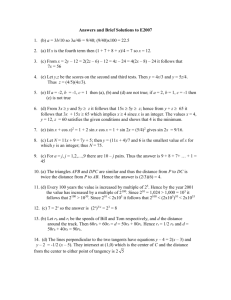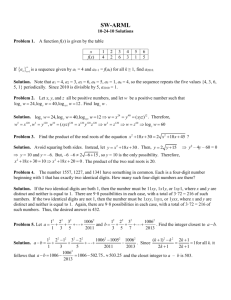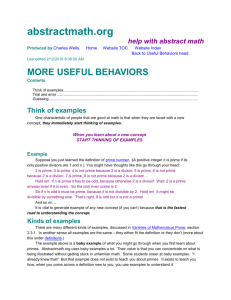docx - Laney College
advertisement
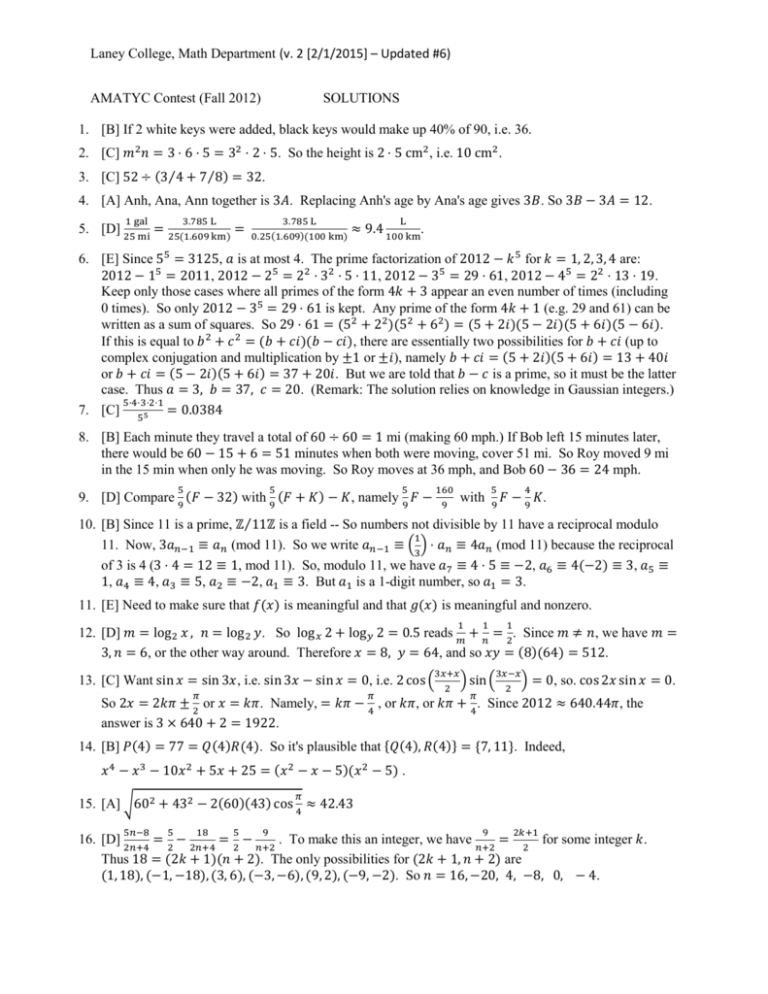
Laney College, Math Department (v. 2 [2/1/2015] – Updated #6)
AMATYC Contest (Fall 2012)
SOLUTIONS
1. [B] If 2 white keys were added, black keys would make up 40% of 90, i.e. 36.
2. [C] 𝑚2 𝑛 = 3 ⋅ 6 ⋅ 5 = 32 ⋅ 2 ⋅ 5. So the height is 2 ⋅ 5 cm2, i.e. 10 cm2 .
3. [C] 52 ÷ (3⁄4 + 7⁄8) = 32.
4. [A] Anh, Ana, Ann together is 3𝐴. Replacing Anh's age by Ana's age gives 3𝐵. So 3𝐵 − 3𝐴 = 12.
1 gal
3.785 L
5. [D] 25 mi = 25(1.609 km) =
3.785 L
0.25(1.609)(100 km)
L
≈ 9.4 100 km.
6. [E] Since 55 = 3125, 𝑎 is at most 4. The prime factorization of 2012 − 𝑘 5 for 𝑘 = 1, 2, 3, 4 are:
2012 − 15 = 2011, 2012 − 25 = 22 ⋅ 32 ⋅ 5 ⋅ 11, 2012 − 35 = 29 ⋅ 61, 2012 − 45 = 22 ⋅ 13 ⋅ 19.
Keep only those cases where all primes of the form 4𝑘 + 3 appear an even number of times (including
0 times). So only 2012 − 35 = 29 ⋅ 61 is kept. Any prime of the form 4𝑘 + 1 (e.g. 29 and 61) can be
written as a sum of squares. So 29 ⋅ 61 = (52 + 22 )(52 + 62 ) = (5 + 2𝑖)(5 − 2𝑖)(5 + 6𝑖)(5 − 6𝑖).
If this is equal to 𝑏 2 + 𝑐 2 = (𝑏 + 𝑐𝑖)(𝑏 − 𝑐𝑖), there are essentially two possibilities for 𝑏 + 𝑐𝑖 (up to
complex conjugation and multiplication by ±1 or ±𝑖), namely 𝑏 + 𝑐𝑖 = (5 + 2𝑖)(5 + 6𝑖) = 13 + 40𝑖
or 𝑏 + 𝑐𝑖 = (5 − 2𝑖)(5 + 6𝑖) = 37 + 20𝑖. But we are told that 𝑏 − 𝑐 is a prime, so it must be the latter
case. Thus 𝑎 = 3, 𝑏 = 37, 𝑐 = 20. (Remark: The solution relies on knowledge in Gaussian integers.)
5⋅4⋅3⋅2⋅1
7. [C] 55 = 0.0384
8. [B] Each minute they travel a total of 60 ÷ 60 = 1 mi (making 60 mph.) If Bob left 15 minutes later,
there would be 60 − 15 + 6 = 51 minutes when both were moving, cover 51 mi. So Roy moved 9 mi
in the 15 min when only he was moving. So Roy moves at 36 mph, and Bob 60 − 36 = 24 mph.
5
9
5
9
5
9
9. [D] Compare (𝐹 − 32) with (𝐹 + 𝐾) − 𝐾, namely 𝐹 −
160
9
with
5
𝐹
9
4
9
− 𝐾.
10. [B] Since 11 is a prime, ℤ⁄11ℤ is a field -- So numbers not divisible by 11 have a reciprocal modulo
1
11. Now, 3𝑎𝑛−1 ≡ 𝑎𝑛 (mod 11). So we write 𝑎𝑛−1 ≡ ( ) ⋅ 𝑎𝑛 ≡ 4𝑎𝑛 (mod 11) because the reciprocal
3
of 3 is 4 (3 ⋅ 4 = 12 ≡ 1, mod 11). So, modulo 11, we have 𝑎7 ≡ 4 ⋅ 5 ≡ −2, 𝑎6 ≡ 4(−2) ≡ 3, 𝑎5 ≡
1, 𝑎4 ≡ 4, 𝑎3 ≡ 5, 𝑎2 ≡ −2, 𝑎1 ≡ 3. But 𝑎1 is a 1-digit number, so 𝑎1 = 3.
11. [E] Need to make sure that 𝑓(𝑥) is meaningful and that 𝑔(𝑥) is meaningful and nonzero.
1
1
1
12. [D] 𝑚 = log 2 𝑥 , 𝑛 = log 2 𝑦. So log 𝑥 2 + log 𝑦 2 = 0.5 reads 𝑚 + 𝑛 = 2. Since 𝑚 ≠ 𝑛, we have 𝑚 =
3, 𝑛 = 6, or the other way around. Therefore 𝑥 = 8, 𝑦 = 64, and so 𝑥𝑦 = (8)(64) = 512.
3𝑥+𝑥
3𝑥−𝑥
) sin ( 2 ) = 0, so. cos 2𝑥 sin 𝑥
2
𝜋
or 𝑘𝜋 + . Since 2012 ≈ 640.44𝜋, the
4
13. [C] Want sin 𝑥 = sin 3𝑥, i.e. sin 3𝑥 − sin 𝑥 = 0, i.e. 2 cos (
𝜋
±
2
𝜋
4
So 2𝑥 = 2𝑘𝜋
or 𝑥 = 𝑘𝜋. Namely, = 𝑘𝜋 − , or 𝑘𝜋,
answer is 3 × 640 + 2 = 1922.
14. [B] 𝑃(4) = 77 = 𝑄(4)𝑅(4). So it's plausible that {𝑄(4), 𝑅(4)} = {7, 11}. Indeed,
𝑥 4 − 𝑥 3 − 10𝑥 2 + 5𝑥 + 25 = (𝑥 2 − 𝑥 − 5)(𝑥 2 − 5) .
𝜋
15. [A] √602 + 432 − 2(60)(43) cos 4 ≈ 42.43
5𝑛−8
5
18
5
9
9
2𝑘+1
16. [D] 2𝑛+4 = 2 − 2𝑛+4 = 2 − 𝑛+2 . To make this an integer, we have 𝑛+2 = 2 for some integer 𝑘.
Thus 18 = (2𝑘 + 1)(𝑛 + 2). The only possibilities for (2𝑘 + 1, 𝑛 + 2) are
(1, 18), (−1, −18), (3, 6), (−3, −6), (9, 2), (−9, −2). So 𝑛 = 16, −20, 4, −8, 0, − 4.
= 0.
Laney College, Math Department (v. 2 [2/1/2015] – Updated #6)
17. [E] From 𝑎2 = 2(𝑏 + 1)(𝑏 − 1) we see that 𝑎 is even and 𝑏 is odd. So 𝑥 = 𝑎 + 𝑏, 𝑦 = 𝑎 − 𝑏 are both
𝑥+𝑦
𝑥−𝑦
𝑥+𝑦 2
,
𝑏
=
,
with
(
) =
2
2
2
√9𝑦 2 − 𝑦 2 + 8 = 3𝑦 + √8(𝑦 2 + 1).
odd, and 𝑎 =
3𝑦 +
𝑥−𝑦 2
)
2
2(
− 2 , i.e. 𝑥 2 − 6𝑦𝑥 + 𝑦 2 − 8 = 0, therefore 𝑥 =
The value 𝑦 = 41 gives an integer value 𝑥 = 239 > 100.
18. [E] 𝑎9 + 𝑎10 = 348, and 82 + 𝑎9 = 𝑎10 . Solve to get 𝑎9 = 133.
19. [B] The overlapping area consists of two 30∘ -60∘ -90∘ right triangles with the longer leg being 2. So
2
the combined area is (2) ( 3) =
√
4√3
.
3
20. [A] Let 𝑃 = 𝑝 − 1, 𝑄 = 𝑞 − 1, 𝑅 = 𝑟 − 1, 𝑆 = 𝑠 − 1. Then 𝑃, 𝑄, 𝑅, 𝑆 are nonnegative integers with
𝑃 + 𝑄 + 𝑅 + 𝑆 = 18 and 𝑃 ≤ 3.
Case 1: 𝑃 = 0, 𝑄 + 𝑅 + 𝑆 = 18: 𝐶218+2 = 𝐶220 =
20⋅19
1⋅2
= 190.
Case 2: 𝑃 = 1, 𝑄 + 𝑅 + 𝑆 = 17: 𝐶217+2 = 𝐶219 =
19⋅18
1⋅2
= 171.
Case 3: 𝑃 = 2, 𝑄 + 𝑅 + 𝑆 = 16: 𝐶216+2 = 𝐶218 =
18⋅17
1⋅2
= 153.
Case 4: 𝑃 = 3, 𝑄 + 𝑅 + 𝑆 = 15: 𝐶215+2 = 𝐶217 =
17⋅16
1⋅2
= 136.
So the answer is 190 + 171 + 153 + 136 = 650.
